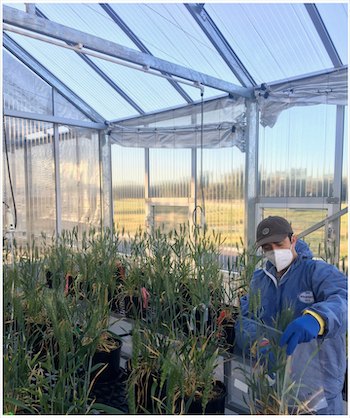GRDC is investing in research to increase understanding and research capacity for developing agronomic methods that can lead to the production of grains with higher nutritional benefit.
The Australian Synchrotron in Victoria is a particle accelerator that produces light that is brighter than the sun. This light intensity is needed to study in great detail the mineral composition of plant material, including grains, requiring minimal sample preparation.
Using instruments at the X-ray fluorescence microscopy beamline, crop scientists can investigate the concentrations and distribution of micronutrients accumulated in dozens of grain samples in a relatively short timeframe.
The project is led by Professor Richard Bell and postdoctoral research fellow Tona Sanchez-Palacios in collaboration with other project leaders – Professor Enzo Lombi from the University of South Australia and Professor Peter Kopittke from the University of Queensland, who have used the elemental imaging facilities to investigative the distribution of nutrients, in particular zinc, in Australian high-yielding wheat grain samples.
Zinc mobility an issue
The restricted mobility of zinc in Australian soils has significant effects on the accumulation of zinc in grains. The stratification of zinc in dry-arable land can restrict root uptake. Even after the surface application of zinc at relatively high rates – more than 20 kilograms of zinc per hectare – on acid sandy soil in south-western Western Australia, zinc remains in the topsoil layer after heavy rain.
In south-western WA, extractable zinc levels at zero to 10-centimetre depths are typically adequate in agricultural soils, but due to the limited mobility, subsoil levels remain very low in available zinc.
“Our preliminary assessments investigating the levels of zinc in wheat grain samples across the wheatbelt over four years confirmed the levels of micronutrients in grains are low compared to global markets, which is concerning,” Professor Bell says.
In response, the research team is developing and testing novel foliar fertilisers containing zinc and other additives that can lead to the increase of zinc concentrations in wheat grains – an approach known as agronomic biofortification, which is part of the ongoing GRDC project investment.
“Biofortification can be done by applying different approaches, including plant breeding, gene editing or soil amendments, which can take a long term to develop and test for efficacy,” Dr Sanchez-Palacios says.
“In comparison, foliar formulations can achieve the same desired outcome in a cost-effective manner, applicable to many wheat varieties and including other crops, and can be adjusted to different agroecological zones undergoing changes in climate. There is great potential.”
 Dr Tona Sanchez-Palacios is applying a novel foliar formulation containing zinc at a later developmental stage on wheat plants cultivated in the GRDC grain precinct facilities at Murdoch University, Western Australia. Photo: Tona Sanchez-Palacios
Dr Tona Sanchez-Palacios is applying a novel foliar formulation containing zinc at a later developmental stage on wheat plants cultivated in the GRDC grain precinct facilities at Murdoch University, Western Australia. Photo: Tona Sanchez-Palacios
The team obtained encouraging results from the last analyses conducted at the Australian Synchrotron in November 2022, where they conducted several studies over three days to measure the degree of enrichment of zinc in deeper layers of the grain endosperm resulting from the foliar application of novel zinc forms on wheat plants.
The elemental imaging facilities at the Synchrotron have been used previously for mapping the elemental distribution of nutrients in grains. The techniques developed at the Synchrotron and the extensive experience of the team members have been key in applying X-ray techniques to investigate the potential of these novel foliar fertilisers for the agronomic biofortification of wheat.
After conducting the Synchrotron studies, Dr Sanchez-Palacios performed more experiments at Lucas Heights, New South Wales’ Australian Nuclear Science and Technology Organisation (ANSTO) facilities.
In collaboration with Dr Tom Cresswell and his research group from ANSTO, the research team are applying nuclear techniques to trace the application of isotope 65 zinc on flag leaves at later developmental stages of wheat. The experiments aim to elucidate the mechanisms of retranslocation and the optimal timing of foliar spray application to achieve a higher potential for grain zinc biofortification.
“The process of zinc foliar application for biofortification of wheat grains requires precise adjustments, including determining the appropriate zinc formulation, dose, timing and environmental factors, to ensure cost-effective results. Developing a low-cost approach would increase its appeal to grain growers seeking to improve grain quality for global markets that are becoming increasingly aware of the importance of human nutrition,” Dr Sanchez-Palacios says.
More information: Dr Tona Sanchez-Palacios, [email protected]; ANSTO article

























































